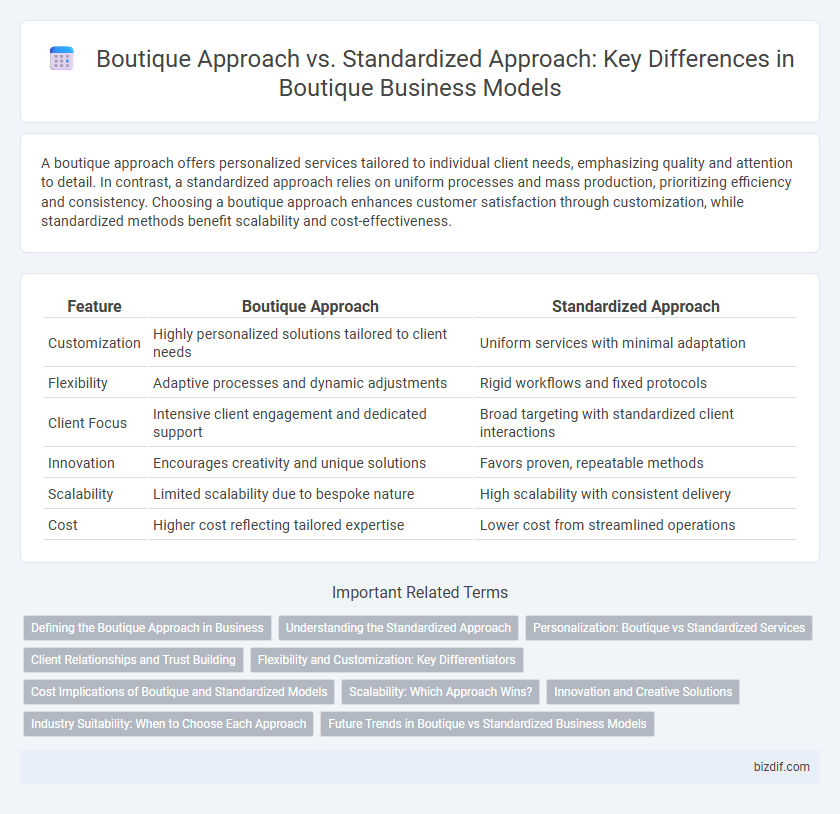A boutique approach offers personalized services tailored to individual client needs, emphasizing quality and attention to detail. In contrast, a standardized approach relies on uniform processes and mass production, prioritizing efficiency and consistency. Choosing a boutique approach enhances customer satisfaction through customization, while standardized methods benefit scalability and cost-effectiveness.
Table of Comparison
| Feature | Boutique Approach | Standardized Approach |
|---|---|---|
| Customization | Highly personalized solutions tailored to client needs | Uniform services with minimal adaptation |
| Flexibility | Adaptive processes and dynamic adjustments | Rigid workflows and fixed protocols |
| Client Focus | Intensive client engagement and dedicated support | Broad targeting with standardized client interactions |
| Innovation | Encourages creativity and unique solutions | Favors proven, repeatable methods |
| Scalability | Limited scalability due to bespoke nature | High scalability with consistent delivery |
| Cost | Higher cost reflecting tailored expertise | Lower cost from streamlined operations |
Defining the Boutique Approach in Business
The boutique approach in business emphasizes personalized services, tailored solutions, and close client relationships, contrasting with the impersonal nature of standardized approaches. This method leverages deep industry expertise and creative problem-solving to meet unique client needs, often resulting in higher customer satisfaction and loyalty. Small-scale operations enable flexibility and innovation, allowing boutiques to adapt quickly to market changes and deliver customized value propositions.
Understanding the Standardized Approach
The standardized approach in boutique settings emphasizes uniform processes and consistent service delivery across all locations, ensuring efficiency and scalability. It relies on predefined protocols and metrics to maintain quality control, reducing variability compared to the personalized boutique approach. This method supports brand coherence and operational predictability, appealing to clients who prioritize reliability over customization.
Personalization: Boutique vs Standardized Services
Boutique services prioritize personalization by tailoring every detail to individual client needs, creating unique and highly customized experiences. Standardized approaches follow uniform processes designed for efficiency and consistency, often sacrificing personalization for scalability. This focus on bespoke solutions enables boutique firms to deliver exclusive, client-centric results that standardized services typically cannot match.
Client Relationships and Trust Building
Boutique firms prioritize personalized client relationships by tailoring services to individual needs, fostering deeper trust and long-term loyalty. This approach contrasts with standardized firms that apply uniform processes, often limiting opportunities for customized interactions and emotional connection. Trust-building in boutique settings relies heavily on consistent communication and a nuanced understanding of client goals, enhancing client satisfaction and retention.
Flexibility and Customization: Key Differentiators
Boutique approaches prioritize flexibility and customization, tailoring products and services to meet unique client needs, unlike standardized approaches which rely on uniform solutions. This flexibility allows boutiques to adapt quickly to evolving market demands and individual preferences, enhancing customer satisfaction and loyalty. Customization in boutique models fosters deeper client relationships and competitive differentiation by delivering personalized experiences unattainable through standardized methods.
Cost Implications of Boutique and Standardized Models
Boutique approaches typically involve higher costs due to personalized services, bespoke product offerings, and limited economies of scale. Standardized models leverage mass production and uniform processes, resulting in lower per-unit costs and greater price competitiveness. Companies must weigh the premium pricing potential of boutique strategies against the cost efficiencies and scalability of standardized approaches.
Scalability: Which Approach Wins?
The boutique approach offers highly customized solutions tailored to specific client needs, which enhances quality but can limit scalability due to resource intensity. In contrast, the standardized approach relies on repeatable processes and uniform products that enable rapid expansion and consistent delivery across markets. For businesses prioritizing scalable growth, the standardized approach typically wins by streamlining operations and maximizing output efficiency.
Innovation and Creative Solutions
The boutique approach emphasizes tailored innovation and creative solutions by leveraging personalized client insights and agile methodologies, driving unique outcomes that standardization cannot achieve. Unlike the standardized approach, which relies on uniform processes and predictable results, boutiques foster a culture of experimentation and bespoke problem-solving that accelerates breakthrough innovations. Investment in specialized expertise and customized strategies allows boutiques to deliver differentiated value and adaptable solutions in dynamic markets.
Industry Suitability: When to Choose Each Approach
The boutique approach excels in industries requiring highly specialized, personalized services such as luxury fashion, bespoke software development, and niche consulting, where client-specific solutions are critical. The standardized approach suits mass-market industries like fast-moving consumer goods, automotive, or telecommunications, where uniformity and scalability drive efficiency and cost-effectiveness. Selecting the right approach hinges on industry demands for customization versus volume, impacting customer satisfaction and operational agility.
Future Trends in Boutique vs Standardized Business Models
Boutique business models emphasize personalized customer experiences and niche market specialization, driving future trends toward hyper-customization and agile innovation. Standardized approaches prioritize scalability and cost-efficiency, but evolving consumer demands push these models to incorporate more flexibility and digital integration. Industry experts predict a hybrid model combining boutique sensitivity with standardized processes to thrive in competitive markets.
Boutique Approach vs Standardized Approach Infographic

 bizdif.com
bizdif.com